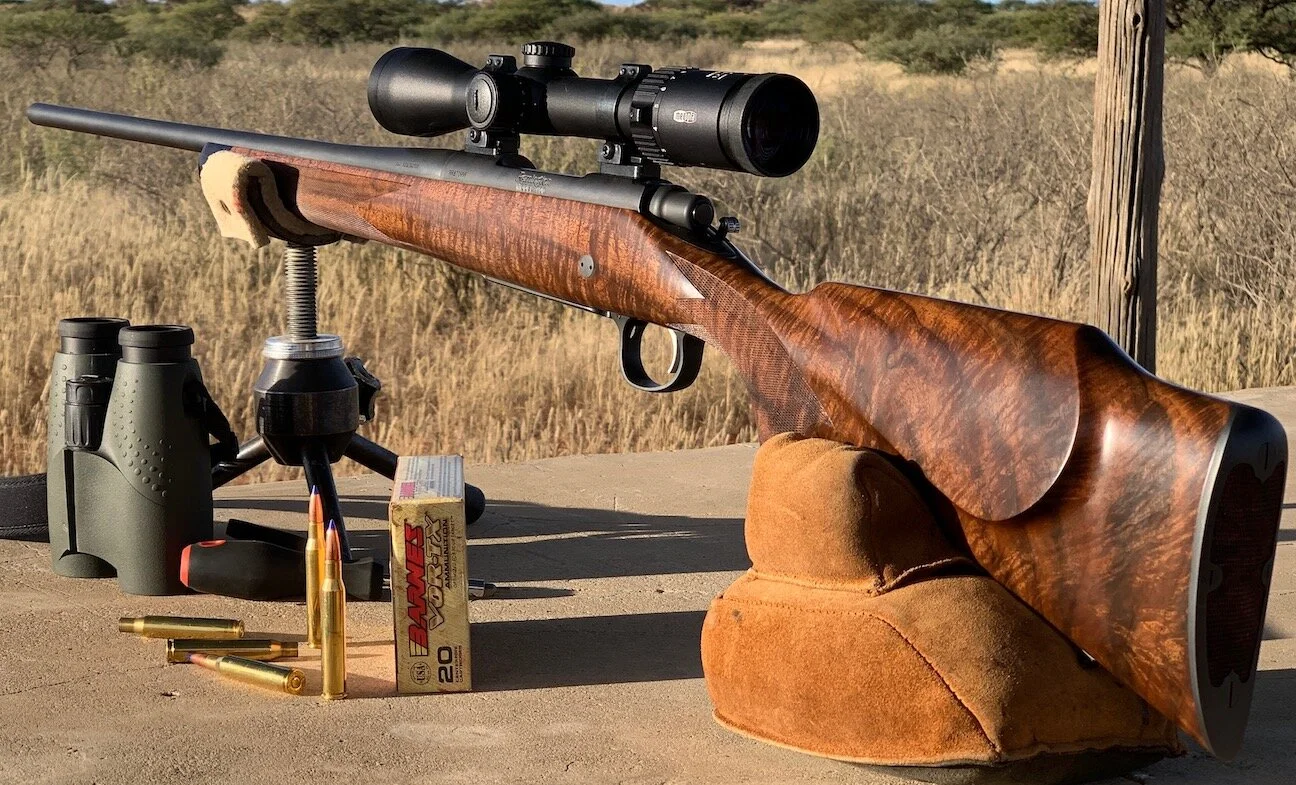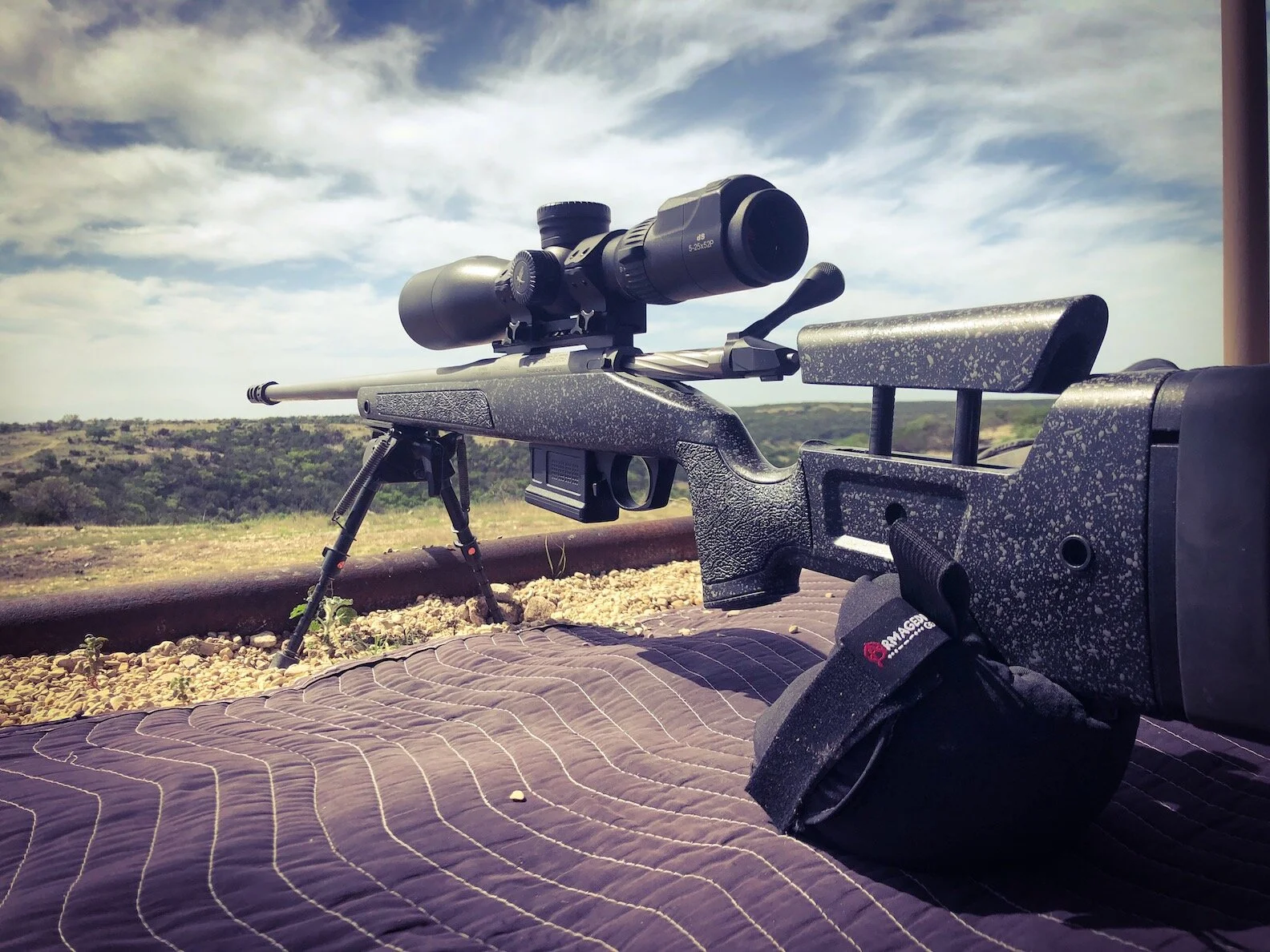Is The Wood Stock Deer Rifle Obsolete?
The wood stock deer rifle isn’t dead. It’s just willfully misrepresented to gin up new rifle sales.
Mossberg's Patriot Revere is a wood stock deer rifle the might look old fashioned, but balances, handles, and shoots MOA regularly, consistently while being a delight to carry and hunt with.
This oldie but goodie is not that old. Mossberg bucked the trend when it came out with the upgraded Patriot Revere three years ago. It's the same rifle as the synthetic stock Patriots, just better looking, warmer, easier on the eyes, and classier. In short, it's a rifle one can take pride in while sacrificing no needed deer hunting performance. This one's chambered in the fully modern (and sometimes despised)
Note the
and
. This rig has accounted for whitetails, mule deer, blacktail, ibex, coyote and lots of paper in temps from 80F to 10F, rain to drought without changing point-of-impact. Why would I want to add nuts and bolts?
Synthetic stock rifles started in the mid-20th century with inexpensive 22 rimfires like Remington’s Nylon and Apache. Synthetics began appearing on custom benchrest rifles in the 1970s. I believe the first commercial centerfire marketed with a synthetic stock was the Weatherby FiberMark around 1986. And now…
Molded plastic, hand-laid fiberglass and Kevlar, aluminum… Twenty-first century hunting rifles look like a Hollywood sci-fi weapon. Or something designed and built by a farm implement manufacturer. (John Deere Deer Rifle?)
I’m not saying these new nuts-and-bolts rifles don’t shoot — and shoot extremely precisely. I’m just saying they don’t look or handle like a rifle I’d enjoy carrying while prowling the world’s savannas, mountains, and woodlands. Or even the back-40 deer lease. Maybe it’s just me, but do we really need stocks displaying a dozen bolt heads, nuts, bars, clamps and… What’s wrong with a traditionally contoured, wood stock deer rifle?
This in not a wood stock deer rifle, but a synthetic stock long range rifle with extra bars, bolts, and adjustments popular with long range target shooters. Questionable value in a deer hunting rifle.
As synthetic nuts and bolts rifle go, Bergara's Premier HMR Pro is inarguably precise, but I see limited value in the adjustable comb and LOP, steep pistol grip, extended drop magazine, etc. in a deer hunting rig. But maybe that's just me.
Old Isn't Obsolete
The deer rifles perfected during the 20th century are often disparaged as old fashioned and too prone to warping to be accurate. Shakespeare addressed this: methinks thou protests too much.
Consider history: Market hunters didn’t nearly wipe out bison, pronghorns, elk, and turkeys because their walnut stocked rifles didn’t work. The wood stock deer rifle — whether lever-action, pump, autoloader, single shot, or bolt — is a proven, nigh perfect amalgamation of materials and design. Such rifles have been tested, tweaked, and proven across the game fields of the world for more than a century. They worked then. They work now. But some better than others. Let’s examine why.
Wood stock deer rifles used to be standard, like this falling block, single-shot, IFG Sharps replica.
Fancy walnut stocks look proper on an old-fashioned rifle like this
replica, but they perform perfectly on fully modern hunting rifles, too. And still look good doing it.
Woodn't You Know It
Not all wood gun stocks are created equal. Some truly are inaccurate. This could be from the wrong kind of wood, a bad chunk of the right kind of wood, poorly laid out and cut wood, or poorly bedded wood. Most of that can be avoided or fixed.
A few commercial wood stock deer rifles are maple (I believe Winchester and Browning are selling some now,) most are walnut, and some are birch stained to look like walnut. The walnuts can be American, English, Turkish, French, Bastogne, Claro… You don’t need to know everything there is to know about all these (or the oddball myrtle, apple and other woods sometimes tried.) You just have to choose a stock that appeals to your eye and make sure it is bedded properly to the barreled action — or how to correct it if it isn’t.
Winchester M70 with maple stock
Winchester is now offering its Super Grade M70 with a maple stock. These were fairly popular in the mid-20th century.
What's a Good Wood Stock Deer Rifle
A good wood stock should be dense and hard (to minimize compression when tightening bedding screws) and feature grain running parallel to the barrel. In other words, any grain structure should run straight from about the pistol grip forward to the tip. This helps prevent weird warping tendencies should you leave the rifle out in the rain overnight. Or paddle your boat with it.
Since the butt stock doesn’t impact the action or barrel, it can include all kinds of enticing swirls and marbling and crotch feathering. Let the grain run wild there and enjoy the look!
Marbling, feathering and mineral grain show in a high grade walnut butt stock.
Swelling, shifting wood in a butt stock doesn't change pressured on a rifle's barrel or action, so let the mineral grain curl, swirl, feather and run wild. The warmth and natural beauty augment bothy the rifle and the hunting experience. This is on a Marlin 1895 lever action from the
You might wonder how any part of the wood stock affects the barreled action. When a rifle fires, the gas pressures (up to 65,000 psi!) behind the bullet plus the torque resulting from bullets engaging the rifling make the barrel vibrate and oscillate. These vibrations determine to a large degree how precisely the barrel spits each bullet. You don’t want the muzzle vibrating upward when one bullet leaves and down when the next leaves. You want consistency. If a stock presses against a barrel differently from time to time, you lose consistency. Point-of-impact changes. Accuracy suffers.
Variable stock pressure on the action can impact accuracy by slightly bending it, altering the bore-to-barrel concentricity. Soft wood that compresses over time gradually changes point-of-impact, too.
Synthetic stock Savage rifle, Bushnell optics, impala
This Savage Lightweight Storm in 223 Rem. shot lights out on a long safari. Rugged, dependable, accurate... But it would look a lot more lovable (to me) in a richly figured walnut stock. Bushnell optics and Federal Fusion ammo (62-grain) contributed to the taking of 8 species during a most successful hunt with
How To Fix Wood Stock Deer Rifle
Most stock pressure issues can be eliminated by isolating the stock from the barreled action. Do this by installing an intervening layer of epoxy (glass bedding) between the two. Most rifle makers do this now, adding at least a thin layer of epoxy in the recoil lug recess within the stock, sometimes under the front receiver ring and, more rarely, under the rear ring and tang. If your rifle doesn’t have these, you can add them yourself with a Brownells Acraglas bedding kit. Just follow directions. It’s easy.
Wood stock deer rifle can be stabilized with epoxy and pillar bedding as shown here.
Epoxy bedding helps minimize wood stock deer rifle bedding pressure shifts. Adding aluminum pillars for squeezing receiver rings against bedding screws without adding pressure to the wood itself helps even more.
An even better option is pillar bedding. This consists of fixing aluminum or steel tubes in the bedding screw holes so that those screws must run up through the tube. They then tighten the bottom of the action (tang and front receiver ring on most rifles) against the tops of the metal pillars instead of the wood stock itself. This eliminates wood-to-metal contact and compression. You have metal-to-metal fit. Consistent pressure. The wood stock can swell or shrink with moisture all its wants. So long as bedding pressure runs from the metal pillars to the steel action, things remain consistent.
Barrel Bedding is Critical -- and Easy
As for the barrel itself, it can be floated (touching no part of the stock) or bedded to the stock. Either approach can be more or less accurate. The idea behind floating barrels is to prevent them from ever touching the stock, no matter how much it might swell or warp. Shot-to-shot vibrations are always the same. To do this just wrap sandpaper around a dowel rod and sand away some of the barrel channel. Little by little, testing often. One or two sheets of paper 18 bond typing paper should fit the gap between barrel and stock for the entire length of the channel.
Paper between barrel and wood stock channel proves they are not touching.
If two sheets of paper fit between barrel and stock, the two should remain pressure free for consistent accuracy.
Some thin, light, sporter-weight barrels don’t shoot well when floated. An option then is to full-length glass bed them tightly to the stock by laying epoxy in the channel. Brownells Acraglas again. Some barrels shoot best if a pressure point is built into the stock near its tip. All of this can be done with Acraglas.
Fear not! Acraglas needn’t be permanent. You can sand it away. I’ll glass bed a stock/barrel that isn’t accurate and if accuracy doesn’t improve, I’ll sand the channel to free float the barrel or leave a small pressure hump near the tip. These are great DIY shop projects that not only improve your rifle’s accuracy, but help you bond with it, no pun intended. Something about customizing a rifle’s performance with your own handiwork makes it extra special.
Hunter Jerry Schnabel with Remington wood stock deer rifle and Namibian warthog he took with it.
Jerry Schnabel hasn't seen any shifts in impacts in his off-the-shelf Remington wood stock deer rifles -- not even when he took one to dry, dry Namibia on safari. Super guide Willy Baas was most pleased with Jerry's shooting!
Additional Wood Stock Benefits
Wood stocks can be rather easily modified and repaired. Cracks and breaks can be glued and screwed like any wood product. Gouges and scratches can be steamed or sanded out. Some pistol grips can be strengthened by epoxying a pin up through the grip. Forends can be stiffened by adding a rod in the channel. Channels can also be hollowed out to reduce weight or filled in with epoxy to stiffen. Butts can be hollowed to reduce weight or to create “trapdoor” pockets in which to store small things like an extra cartridge or an oil rag. Stocks can be stripped, sanded, stained and refinished to your taste.
Wood stocks are also valued for their warmth and beauty. Get a stock with a bit of figure in the wood and even if you don’t see a deer all season, you can enjoy looking at that beautiful wood grain!
Hunter, roan, Dakota M10 walnut stock rifle
I can't say I was surprised when this walnut-stocked Dakota M10 falling block single shot in 7x57mm Mauser dropped this fine roan antelope. Somehow walnut stocks just keep on keeping on. Note the Talley rings as well as action and lever have been case colored compliments Dakota Custom Shop. Dakota knows how to capture the beauty and romance of hunting rifles without sacrificing a scintilla of performance.
Don’t be afraid to buy, own, and hunt with a walnut stock deer rifle. Or bear, elk, moose, coyote rifle. Built right, they are every bit as effective as most synthetic stocked rifles — and better looking.
While the author uses and appreciates a variety of synthetic stock rifles for their rugged durability and consistency, he retains a soft spot for high-grade, richly figured walnut.






















